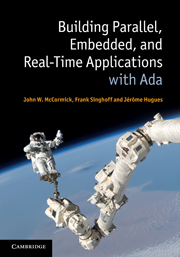Book contents
- Frontmatter
- Contents
- List of illustrations
- List of tables
- Foreword
- Preface
- 1 Introduction and overview
- 2 Sequential programming with Ada
- 3 Task basics
- 4 Communication and synchronization based on shared objects
- 5 Communication and synchronization based on direct interaction
- 6 Distributed systems with Ada
- 7 Real-time systems and scheduling concepts
- 8 Real-time programming with Ada
- 9 Tools for building and verifying real-time applications
- References
- Index
1 - Introduction and overview
Published online by Cambridge University Press: 01 June 2011
- Frontmatter
- Contents
- List of illustrations
- List of tables
- Foreword
- Preface
- 1 Introduction and overview
- 2 Sequential programming with Ada
- 3 Task basics
- 4 Communication and synchronization based on shared objects
- 5 Communication and synchronization based on direct interaction
- 6 Distributed systems with Ada
- 7 Real-time systems and scheduling concepts
- 8 Real-time programming with Ada
- 9 Tools for building and verifying real-time applications
- References
- Index
Summary
The arrival and popularity of multi-core processors have sparked a renewed interest in the development of parallel programs. Similarly, the availability of low-cost microprocessors and sensors has generated a great interest in embedded real-time programs. Ada is arguably the most appropriate language for development of parallel and real-time applications. Since it was first standardized in 1983, Ada's three major goals have remained:
Program reliability and maintenance
Programming as a human activity
Efficiency
Meeting these goals has made Ada remarkably successful in the domain of mission-critical software. It is the language of choice for developing software for systems in which failure might result in the loss of life or property. The software in air traffic control systems, avionics, medical devices, railways, rockets, satellites, and secure data communications is frequently written in Ada. Ada has been supporting multiprocessor, multi-core, and multithreaded architectures as long as it has existed. We have nearly 30 years of experience in using Ada to deal with the problem of writing programs that run effectively on machines using more than one processor. While some have predicted it will be another decade before there is a programming model for multi-core systems, programmers have successfully used the Ada model for years. In February 2007, Karl Nyberg won the Sun Microsystems Open Performance Contest by building an elegant parallel Ada application (Nyberg, 2007). The parallel Ada code he wrote a decade earlier provided the foundation of this success.
- Type
- Chapter
- Information
- Publisher: Cambridge University PressPrint publication year: 2011



